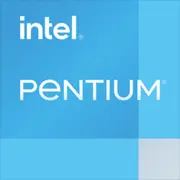Intel Pentium 8505 (IPU)

Intel Pentium 8505: Budget Processor for Everyday Tasks
March 2025
Architecture and Process Technology: A Hybrid Approach for Balance
The Intel Pentium 8505, manufactured using Intel 7 technology (10 nm), belongs to the Alder Lake-U lineup. Its hybrid architecture combines 1 Performance-core (P-core) and 4 Efficient-cores (E-cores), totaling 5 cores and 6 threads. The P-core operates at a base frequency of 1.2 GHz with turbo boost reaching up to 4.4 GHz, while the E-cores can reach up to 3.3 GHz. This approach allows for task distribution: the P-core handles "heavy" single-threaded operations (such as launching applications), while the E-cores manage background processes.
The integrated UHD Graphics (48 EU) is based on the Xe-LP architecture. It supports 4K displays, hardware decoding for video formats (AV1, H.265), and provides basic performance for less demanding games. In comparison, 48 EU is half of that found in the Iris Xe (96 EU), but sufficient for working with office applications and streaming video.
Power Consumption and TDP: Balancing Power and Battery Life
The processor has a TDP of 15 W, typical for ultrabooks and thin laptops. In idle mode, power consumption drops to 2–5 W thanks to the following technologies:
- Intel Speed Shift – dynamic frequency adjustment to minimize latency.
- C-states – disabling unused cores.
- Adaptix – optimizing settings through the Intel Dynamic Tuning utility.
Under peak loads (for example, video rendering), the processor can temporarily exceed the TDP up to 25 W, but the laptop's cooling system quickly returns it to normal levels.
Performance: What Can the Pentium 8505 Do?
Office Tasks:
- Launching a browser with 10+ tabs, Microsoft Office, Zoom – smooth operation.
- PCMark 10 test: ~3200 points (comparable to Core i3-1115G4).
Multimedia:
- Streaming 4K video on YouTube: CPU usage – 15–20%.
- Simple video editing in DaVinci Resolve: rendering a 1080p video in 3–4 minutes.
Gaming:
- CS:GO at low settings (720p) – 40–45 FPS.
- Minecraft (without shaders) – 50–60 FPS.
- The processor is unsuited for games like Cyberpunk 2077.
Turbo Boost Mode:
In single-threaded tasks, the P-core boosts to 4.4 GHz, but maintains this frequency for only 10–15 seconds. In multi-threaded scenarios (for example, file archiving), all cores are engaged at approximately 2.8 GHz.
Usage Scenarios: Who Is This Processor For?
- Students: working on texts, online courses, watching lectures.
- Office Workers: Excel, PowerPoint, corporate applications.
- Home Users: web browsing, social media, Netflix.
- Travelers: compact laptops with long battery life.
Not suitable for: gamers, engineers (CAD, 3D modeling), videographers.
Battery Life: How Long Will the Laptop Last?
With a battery capacity of 50 Wh:
- Video Streaming: up to 10 hours (brightness at 150 nits, Wi-Fi on).
- Web Browsing: 7–8 hours.
- Peak Load: 2–3 hours.
Energy savings are provided by:
- Display Power Saving Technology – automatic brightness adjustment.
- Connected Standby – background app updates during sleep mode.
Tip: choose laptops with IPS screens and Full HD resolution — they are less power-hungry than 4K panels.
Comparison with Competitors: AMD, Apple, and Previous Generations
1. AMD Ryzen 3 7420U (Zen 2, 4 cores/8 threads):
- Pros: better performance in multi-threaded tasks (e.g., rendering).
- Cons: outdated architecture, Radeon 610M graphics weaker than UHD 48EU.
- Laptop prices: $450–600.
2. Apple M1 (8 cores):
- Pros: twice the performance, 18 hours of battery life.
- Cons: macOS limits software compatibility, starting price of $999.
3. Intel Core i3-1215U (Alder Lake-U):
- Pros: 6 cores (2P+4E), Iris Xe graphics (64 EU).
- Cons: laptops are $100–150 more expensive.
Conclusion: The Pentium 8505 is a compromise for those looking for a cheaper option than the Core i3 while not ready to switch to AMD.
Pros and Cons of the Pentium 8505
Strengths:
- Low-priced laptops (starting from $400).
- Support for Wi-Fi 6 and Thunderbolt 4.
- Adequate performance for basic tasks.
Weaknesses:
- Only 1 P-core — a bottleneck in single-threaded loads.
- No support for PCIe 4.0 (only PCIe 3.0 x8).
- Graphics not suitable for games released after 2020.
Laptop Selection Recommendations
1. Device Type: ultrabooks (Acer Swift 3, Lenovo IdeaPad Slim 5) or 2-in-1s with touch screens.
2. RAM: at least 8 GB LPDDR4X. Recommendation: models with upgrade possibilities to 16 GB.
3. Storage: SSD 256 GB (NVMe preferred over SATA).
4. Display: IPS matrix, Full HD resolution. Avoid TN panels.
5. Port: USB-C with charging support for versatility.
Prices for new models:
- Basic configurations: $400–500.
- Premium models (aluminum chassis, backlit keyboards): $550–650.
Final Conclusion
The Intel Pentium 8505 is a good choice for:
- Budget-constrained users.
- Those who appreciate portability and long battery life.
- Individuals not demanding "heavy" performance from their laptop.
Key benefits: low price, energy efficiency, support for modern interfaces. However, for gaming or professional tasks, it may be worth considering a Core i5 or Ryzen 5.
Basic
CPU Specifications
Memory Specifications
GPU Specifications
Share in social media
Or Link To Us
<a href="https://cputronic.com/cpu/intel-pentium-8505-ipu" target="_blank">Intel Pentium 8505 (IPU)</a>